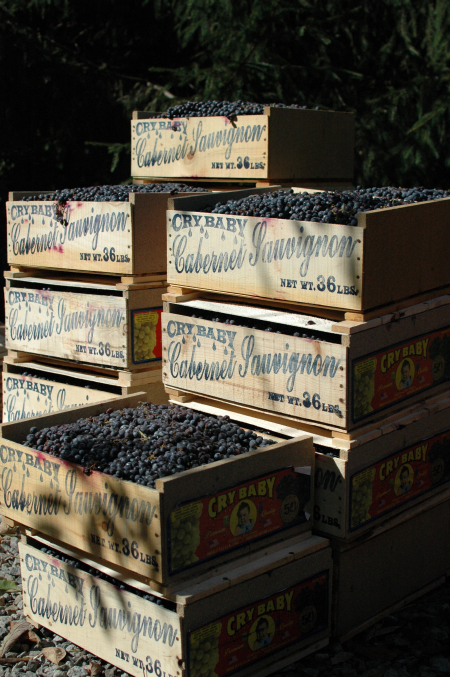Sunday 9/26/2010
Yesterday officially started the Bertolina Wine season for 2010! For this year I've decided to journal some of our thoughts, processes, and activities. The first entries will be on this email, and subsequent postings will be found on www.bertolinawines.com, hopefully in the near future. You've been included on this email since interest has been shown in Bertolina Wines.
Autumn is the busiest, most labor intensive time of the wine making process. After the long warm days of the summer growing season the grapes have ripened and are ready for harvest. Once the grapes are off the vine, the clock is ticking in a battle between each berry and the forces of natural yeasts, bacteria, and oxygen. For most commercial wineries this isn't much of a problem since they often process the grapes right next to where they're grown. But that's not the case for us. Even facing the challenges of a cross-country transportation, unpredictable quality, and varietal availability in constant flux, we still like to think there's magic to be made.
But this year is different; Bertolina's 2010 Riesling is going to be sourced by us, on-site, at the vineyard. While happy with the results from last year's dry 2009 Riesling, we found the quality of the delicate flavors of a typical Riesling significantly toned down. This is likely due to the high vine yields produced at the California vineyards we source from. For this year's run of Riesling, we've sourced 500lbs of grapes from the Fall Bright vineyard in the Finger Lakes region of New York State (http://www.fallbright.com/). Estimated pickup for the Riesling is on October 23. We are very excited for our first visit to a vineyard where we source our grapes. Time permitting, we'll try and talk to the viticulturist and get a good idea of the terroir (terh-warh) of the land. If we have good success, next year expect to see a Finger Lakes red wine too!
For this year we are considering buy-ins on a per bottle basis. This is of final, actually bottled wine; not necessarily that of estimated yield. (We're all in this together...so if we get more juice, we get more wine, you get more wine. The same goes for less.) Attached is an Excel spreadsheet containing all the pertinent data. If you're interested in buying wine, fill out the green section with bottle counts and send back the spreadsheet. You are responsible for supplying your own empty, clean, ready to be filled wine bottles. We're not in this for a profit, we're just having fun. So please remember there are no guarantees and that past yield and quality performance is not necessarily indicative of future performance. Lastly, we're only looking to shove-off about 200 bottles, so we reserve the right to alter your desired quantity and final cost down.
To recap what's happened so far:
-We've put a 25% deposit on an order of 500 lbs of Riesling grapes from Fall Bright in Dundee, NY. We expect this to net us 100L of Dry Riesling Wine (approx 125 bottles).
-On Saturday 9/25 we purchased our red grapes, crushed, destemed, transferred to fermentation vats, and pitched the yeast...all 1863 lbs!. This would not have been so easy without the industrious help of my brother Mark and Dr. Brianna.
-Initial brix (sugar) readings were about 22-23 degrees. This data is used to determine potential alcohol and monitor the fermentation process.
-As we did last year, we're using ICV-D80 yeast on our Red wines. D80 is a strain isolated from the Côte Rôtie area of the Northern Rhône Valley region of France, a region notable for producing ink-black wines of equal quality to those of Bordeaux. D80 works best with Cabernet Sauvignon, Merlot, Syrah, and Zinfandel. The Bertolina opinion of a yeast's influence on the final product is high and much consideration has gone into selecting this yeast.
The manufacturer says: "On the palate it creates high fore-mouth volume, big mid-palate mouthfeel, an intense, fine-grain tannin sensation and a long lasting licorice finish. Selected for its ability to bring out differentiated varietal aromas by reinforcing the rich concentrated flavors found in varieties such as Zinfandel and Syrah."
-Once again as we did last year, we're using VL1 yeast on our White wine. Our expectation is to produce a dry white wine, reckoning those of Alsace, France.
-This will be the second year for a malolactic secondary fermentation. While a consensus still hasn't been made on last year's malolactic results, in my opinion the 2009 Merlot is by far the best we've ever made (and when blended with the 2009 Cabernet Sauvignon, it's truly excellent). This year VP41 strain was selected for its low nutrient requirements, high alcohol tolerance, and high sulfur dioxide tolerance.
Cheers,
Nick
|

